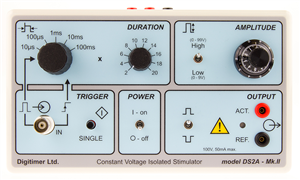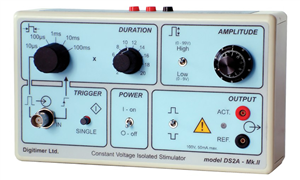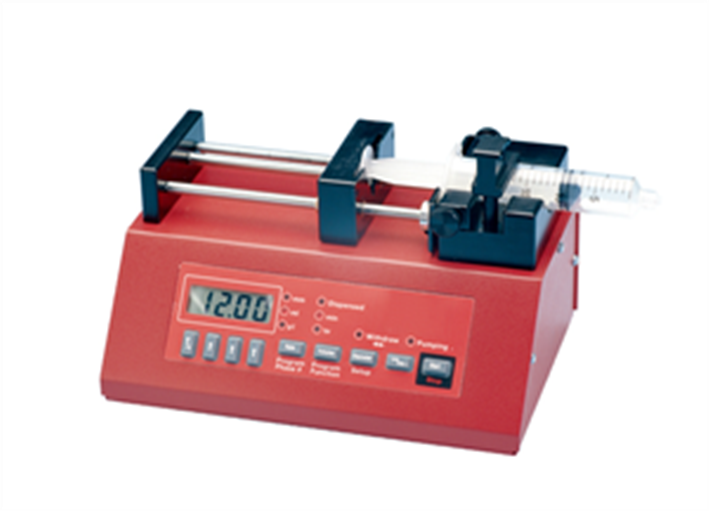

DS2A
Isolated Voltage Stimulator
- Overview
- Specifications
- Accessories
- Citations
- Related Products
Overview
FEATURES
- Low noise battery power supply with up to 99V output
- Internal (20µs to 2s) or external TTL “gated” control of pulse duration
- Two voltage ranges (0-9V and 0-99V) allow precise reproducible control of stimulus output
- Polarity reversal switch
- Battery test sockets
The DS2A Isolated Constant Voltage Stimulator is a low noise solution for electrical stimulation of in vivo and in vitro preparations, in order to excite neurons, nerves or muscle fibres. Battery powered and isolated from its trigger source and ground, the DS2A is designed to deliver precisely adjustable voltage pulses, without introducing noise into electrophysiological recordings. The DS2A will output monophasic voltage pulses of up to 100V, which are widely adjustable in pulse duration and amplitude.
As with the DS3 Constant Current Stimulator the output comes from self-contained alkaline batteries and the unit includes conveniently located battery test sockets. The DS2A can be triggered or “gated” on by a TTL compatible external device, including our DG2A Train/Delay Generator. The DS2A and DS3 also feature a polarity control switch and a front panel single-shot trigger button.
If desired, the DS2A can be installed into our 19″ rack mounting frame (D121-11) which can hold up to two DS2As or a DG2A and DS2A.
Includes
Operator’s Manual
One set of batteries (fitted)
One Pair of output plugs for user assembly (NL985P)
FAQ's
I want to stimulate with a longer pulse duration than 2 seconds, in order to lesion some tissue, is it possible to do this?
Yes, there are two simple methods. (i) The DS3 has the ability to be gated by an external pulse i.e. when external control of pulse duration is selected the output stimulus timing will be controlled by the trigger-in stimulus pulse. It should be noted that (with a 5V input pulse) there is only a very short delay of <2µs for the turn-on and <6µs for the turn-off. When a typical TTL pulse is used, which will only be about 3V, these are matched at 4µs each. (ii) Alternatively, if a trigger pulse is not available or exact timing is not crucial (for instance when lesioning or injecting dye, there is a jumper which can be set to allow the unit to deliver a current for the duration the single shot button is held down. The internal SINGLE jumper determines the output delivered when the SINGLE button is pressed (when EXTERNAL Duration is selected). MON (factory setting) produces a very short pulse ~10µs when pressed. CONT produces an active output for the duration of the press. This could be useful in dye marking etc.
I want to stimulate with a longer pulse duration than 2 seconds, in order to lesion some tissue, is it possible to do this?
Yes, there are two simple methods. (i) The DS3 has the ability to be gated by an external pulse i.e. when external control of pulse duration is selected the output stimulus timing will be controlled by the trigger-in stimulus pulse. It should be noted that (with a 5V input pulse) there is only a very short delay of <2µs for the turn-on and <6µs for the turn-off. When a typical TTL pulse is used, which will only be about 3V, these are matched at 4µs each. (ii) Alternatively, if a trigger pulse is not available or exact timing is not crucial (for instance when lesioning or injecting dye, there is a jumper which can be set to allow the unit to deliver a current for the duration the single shot button is held down. The internal SINGLE jumper determines the output delivered when the SINGLE button is pressed (when EXTERNAL Duration is selected). MON (factory setting) produces a very short pulse ~10µs when pressed. CONT produces an active output for the duration of the press. This could be useful in dye marking etc.
I can't decide between the constant current DS3 and constant voltage DS2A MkII- how should I choose?
The visible difference between the two units (apart from the colour!) is that the output control of the DS2A is defined in Volts while the output of the DS3 is defined in Amps. The actual stimulus passing through your preparation is measured in Amps in both cases and is dependent upon Ohms Law (V = IR). If your preparation has a variable impedance (R) and you are using a constant voltage (V) source such as the DS2A, then the actual current (I) passing through the tissue may vary considerably between each stimulus, which may not be a good idea if you want to apply reproducible stimuli. With the DS3, the constant current circuitry prevents variations in tissue impedance from altering the size of current applied (within the 90V compliance limit of the unit), leading to the stimulator equivalent of WYSIWYG (What You Set Is What You Get). Unfortunately there are no well defined rules governing the circumstances under which either stimulator should be used. If you are not sure and feel the need to evaluate either or both please contact us.
If the DS2A or DS3 is connected to the TTL generating device which is grounded, will the stimulus delivered be still isolated? In other words, would it be safe to use it with patch-clamp, or there is a risk of destroying of the patch-amplifier?
Absolutely. The output of the DS2A or DS3 is optically isolated from the trigger inputs, so there is no need to worry about what your trigger source is, or how it is grounded.
Can the DS2A, DS3 or DS4 be used to stimulate human subjects?
Neither the DS2A, DS3 nor DS4 have medical device directive (MDD) certification and have not been designed for safe human use. We offer a range of medical device compliant stimulators for patient connection as well as a range of stimulators designed for safety in human research studies.
What is the maximum trigger rate of the DS2A or DS3?
The unit can be triggered fast enough to allow >99% ?on? time, but the ?off? time must >20 microseconds ? so, very fast!
I would like to stimulate neurons using 20V 1ms long pulse applied at 10Hz frequency for 30 seconds. Such train should be programmed elsewhere as a train of TTL pulses and delivered to the stimulator, am I right?
Correct, you should program your DAQ interface to deliver trigger pulses @ 10Hz for 30s via a digital output. The DS2A will trigger on each rising edge and the stimulus duration will be set to 1ms using the controls on the DS2A front panel, with the voltage set to 20V.
Is it possible to use two DS2A stimulators in series in order to stimulate through the same electrodes with different pulse types?
Yes, this is quite simple to setup and has been summarized in an application note available in the downloads section.
What is the frequency at which the pulses are delivered when the trigger button is pressed in conditions when jumper is set to cont?
The trigger button has no effect of trigger frequency. It is designed to allow the user to press and hold the Trigger Button to deliver a continuous single stimulation pulse while it is held down. This can be useful for electrical lesioning of a recording site once an experiment is complete.
Are any of your stimulators MRI compatible?
Our stimulators are not classed as MRI safe, as all of them contain ferrous materials which means they cannot be used within a magnetic field. However, as long as they are located beyond the reach of magnetic field or in the scanner control room they may be used. It is important that MRI compatible electrodes and cables are used within the scanner room
Specifications
Output:Two ranges provide 99V (high) and 9V (low) maximum output. A multi-turn dial allows output to be selected as a percentage of maximum. Square wave pulse profile with typical rise time <1µs and fall time <3µs into resistive load.
Pulse Duration: Range:20µs to 2s. One dial allows continuous adjustment from 2 to 20, while another is used to select the range (from 10µs, 100µs, 1ms, 10ms, 100ms or external source). Internal pulse duration values have ± 10% accuracy.
Output terminals: A pair of 2mm touch-proof sockets on the front panel spaced at 0.75”.
Polarity Switch: Normal: Red output terminal positive.Reverse: Red output terminal negative.
Indicator: An LED operates for the duration of each output pulse.
Overload: An automatic overload circuit prevents excessive output current being drawn by reducing the output pulse duration to <10µs when a current of greater than 50mA is detected.
Single Shot: A single-shot push button is provided. This operates at all times irrespective of trigger input.
Trigger: A positive pulse of between 3V and 20V is required to trigger the stimulator.The trigger input current varies from 6mA to 62mA over the above voltage range. Trigger pulse duration should not normally be less than 4µs.
Trigger Isolation: Optical coupling is employed between the trigger source and the stimulator circuitry. The capacity coupling is less than 3pF.
Batteries: 11 x PP3, IEC-6R61 style batteries. Current is only drawn when delivering a pulse. Note that battery test sockets are built-in.
Mounting: One or two stimulators may be mounted in a 19” rack using a specially fabricated frame (model D121-11) available from Digitimer Ltd.
Dimensions: Panel size: 190mm x 110mm. Depth: 80mm over knobs.
Weight: 800g complete with batteries.






Request
Catalogue
Chat
Print